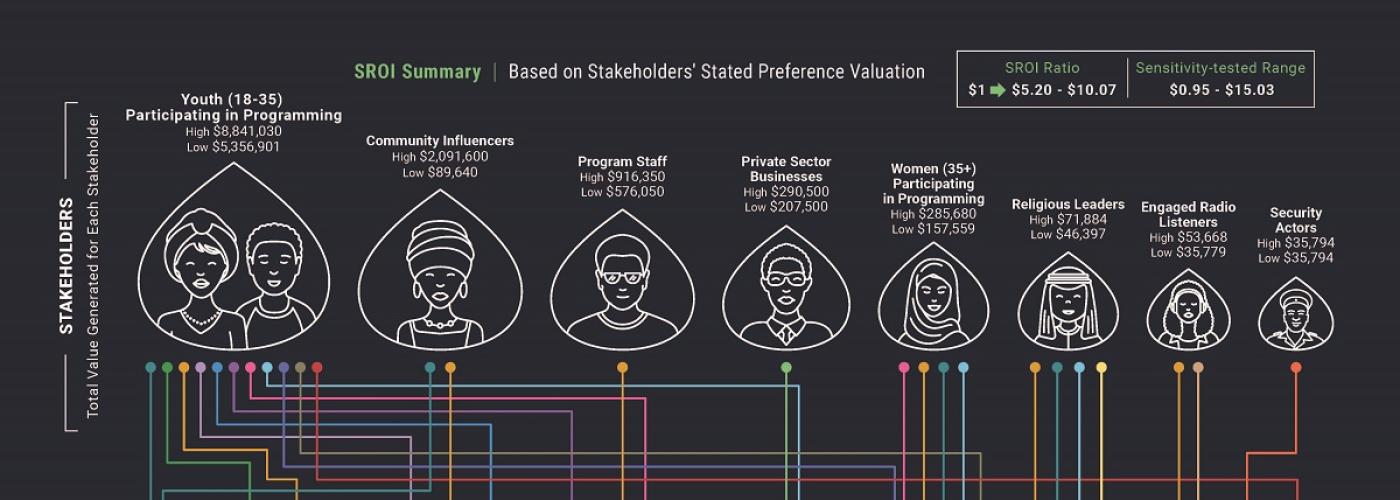What Do We Know about the Impacts and Social Return on Investment (SROI) of Peacebuilding Interventions
Image

Around the globe, communities are faced with complex challenges and facilitating and sustaining peace remains of critical importance. While peacebuilding programming is implemented throughout the world, little is known about the overall impact and return on investment of these programs. Historically, program evaluations in this field (and in international aid and development broadly) have offered information on outputs, for example the number of people who participated in training, but this information remains insufficient to truly understand the impact.
So what if 500 or 5000 people participated in a conflict resolution training, what did that do? How did their lives change? What was the broader impact for the community? How long did the changes last? And was it worthwhile? These are the types of questions decision-makers, including those working and investing in the youth, peace & security (YPS) space, often want to know but don’t have all the evidence to answer.
To fill this gap, our team conducted a proof-of-concept study (supported by USAID and conducted in collaboration with many partners) where we evaluated the impact of peacebuilding interventions using the social return on investment (SROI) methodology. In this study, we applied the SROI methodology to four youth-led and youth-supporting peacebuilding programs implemented in Kenya, and did a further follow up study on the impact of these programs in the context of the national elections, which have historically been tense periods.
This study surveyed a range of stakeholders affected by the peacebuilding interventions including youth, women, security actors, the State, religious leaders, the private sector, program staff and more. These stakeholders experienced various outcomes, with increased networking and opportunities being one of the most important and longest-lasting outcomes for them.
For the young people in particular, because of the high degree of exclusion they often experience, and a sense of belonging they crave, they valued being connected more than they even valued having a job in this particular case. The study found a generally positive SROI across all the programs and that outcomes were even more highly valued by stakeholders in the tense context of the election.
Takeaway #1: The SROI studies elucidate the value of peacebuilding and can inform smarter investments in improving state-society relationships.
Key findings of the study included:
- For every $1 invested in these programs, it generated $5-$10 in social value (according to stakeholders).
- Youth-led peacebuilding programs have broad societal impact across key stakeholders beyond youth, including the State and the private sector
- Stakeholders found these outcomes to be most important to them: increased networking and opportunities, becoming an upstanding member of society, and increased capacity for peacebuilding.
The findings are currently being used to:
- Inform future program design and implementation
- Inform and raise investment, and, particularly the engagement of the private sector
- Support the development of national actions plans and strategies by providing better ways to understand program strategy that is inclusive of people most impacted
Takeaway #2: Adding the SROI approach to current evaluation practices can lead to greater evidence of impact and clearer people-centered outcomes.
SROI methodology (as outlined by Social Value International):
- Prioritizes the voice of all key stakeholders and what matters most to them. It does this by asking stakeholders what outcomes they experienced and their relative importance of them. Through this process, SROI allows for the measurement of ‘softer’ intangible outcomes as opposed to solely focusing on ‘hard’ tangible or economic outcomes. These ‘softer’ outcomes are often excluded from traditional program evaluation and economic analyses due to the difficulty of quantifying them. However, this analysis found that these intangible outcomes (i.e., increased empowerment and inclusion, and increased networking) were the most important to stakeholders.
- Provides insights to avoid or mitigate harmful effects. SROI engages key stakeholders in considering both any positive and negative consequences they might have experienced, which can be used to mitigate these harms from occurring in the future.
- Examines sustainability by considering how long outcomes last and factors those into the calculations of value.
- Elucidates value for money. While most programming in this space has inherently been understood as valuable by program staff and donors, SROI makes that value explicit by assigning a dollar value to outcomes.
- Encourages decision-making based on value, not outputs, which do not reflect the whole picture yet have often been the basis for many decisions.
Takeaway #3: The SROI approach can facilitate localization.
As USAID and other international aid and development organizations have outlined broader aims of local ownership and partnership, and inclusive development in design, approach and impact, this study shows that SROI can provide measurement and valuation authority to those who are actually experiencing programming, compared to how many traditional evaluations are done. In Social Value International’s methodology for SROI:
- Stakeholders define the outcomes they experience and the indicators for measurement.
- Stakeholders define the relative value of outcomes.
- Stakeholders define the overall impact and future priorities.
While SROI is not a panacea and still faces its criticisms, it can be a valuable tool for decision-makers interested in knowing and improving their impacts and investments.
Authors:
Shubha Kumar (University of Southern California) and Saji Prelis (Search for Common Ground)

